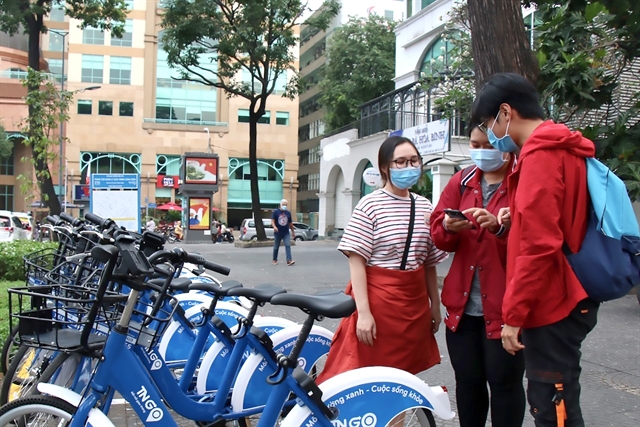
HÀ NỘI — Residents and tourists in Hà Nội will soon have more options for getting around after city authorities approved 200 public bicycle stations.
Under a pilot project by the city’s Department of Transport, which is set to start at the end of the year, up to 2,000 bicycles will be available at 200 stations in seven districts of Tây Hồ, Ba Đình, Đống Đa, Thanh Xuân, Hoàn Kiếm, Hai Bà Trưng and Cầu Giấy, as well as around stations on the Cát Linh – Hà Đông urban railway.
The public bicycle service will provide city-dwellers with a modern, convenient and environmentally friendly means of transport, increasing connectivity between public transport, as well as urban areas and office buildings, the department said.
The service is expected to have little impact on traffic flow, the department said.
Đào Việt Long, deputy head of the department, expects the project to gradually change people’s travel habits and reduce environmental pollution.
Public bicycles will initially form an auxiliary network to help connect people to bus stations, he added.
Đỗ Bá Dân, Chairman of the Board of Directors of Trí Nam Group Joint Stock Company – the project investor – said that the service would come into operation in the fourth quarter of this year, at the latest.
Bicycles used for the project consist of pedal-powered and electric models.
It is expected that the cost for each 30-minute ride will be VNĐ5,000 (US$0.2) for traditional bicycles and VNĐ10,000 ($0.4) for electric bicycles.
People who rent a bicycle for the whole day will pay VNĐ60,000 ($2.5) for a traditional bicycle and VNĐ120,000 ($5) for an electric bike.
Riders will be able to buy daily, monthly, quarterly and yearly tickets and pay using their banking application or e-wallet.
In the short term, the first phase of the project will be implemented in the nine districts between 2022 and 2023. In the second phase, which will be run between 2023 and 2024, about 3,000 bicycles will be placed at 350 stations.
Associate Professor Vũ Anh Tuấn, director of the Việt Nam – Germany Transport Research Centre, told Kinh Tế & Đô Thị (Economic and Urban Affairs) online newspaper that public bicycles connecting to the public transport system is necessary to reduce the number of people using private vehicles and help them switch to public transport.
“This is a civilised solution to help reduce environmental pollution applied in advanced countries,” he said.
He also said that the city should consider a plan to subsidise prices so that the cost of travelling by public bicycle is cheaper than by private vehicles, he added.
Since December 2021, a public bicycle service has been operated in HCM City by the company and has received positive feedback.
Infrastructure for bicycles
According to experts, the trend of sustainable urban development is promoting the role of bicycles – a green, clean and environmentally friendly means of transport.
Many cities such as Copenhagen (Denmark), Amsterdam (the Netherlands), Berlin (Germany), Strasbourg (France) and Beijing (China) have re-shaped urban infrastructure in a way that encourages bicycles, such as building separate bridges, lanes and parking areas for bicycles.
The most bike-friendly city in the world is Copenhagen with 62 per cent of work and school journeys made by bike.
Phạm Hoài Chung, an expert on transportation strategy, said that in order to develop public bicycle service, first and foremost, it is advisable to create a safe and secure environment, thereby attracting a large number of people and tourists using public bicycles.
Reserved lanes and intersections need to be designed to support bicycle riders to move efficiently and safely, he said.
Next, a suitable network of parking locations is necessary, as well as connections with other modes of transport, he said.
Third, applying technology in running the public bicycle service will help people accessing it conveniently and using it easily, he said.
However, in major cities, including Hà Nội, infrastructure for bicycles is believed to be a huge challenge and barrier to developing public bicycle services, he said.
Therefore, Chung said the city should build infrastructure for bicycles in downtown areas and then develop it gradually.
If there are no large sidewalks or roads with wide cross-sections to arrange bicycle lanes, riders need to be given priority with a separate signage system when they are on the roads, he said.
Vũ Hoài Nam, a lecturer at the Faculty of Bridges and Roads under the University of Civil Engineering, said that the issuance of guidelines for the design of bicycle infrastructure in urban areas is necessary.
In addition to reducing the risk of accidents for cyclists, the design of bicycle infrastructure also contributes to promoting the development of urban public transport systems, shifting traffic demand in the direction of using environmentally-friendly public transport, he said. — VNS
- Reduce Hair Loss with PURA D’OR Gold Label Shampoo
- Castor Oil Has Made a “Huge” Difference With Hair and Brow Growth
- Excessive hair loss in men: Signs of illness that cannot be subjective
- Dịch Vụ SEO Website ở Los Angeles, CA: đưa trang web doanh nghiệp bạn lên top Google
- Nails Salon Sierra Madre
 VnExpress News The News Gateway of Vietnam
VnExpress News The News Gateway of Vietnam





